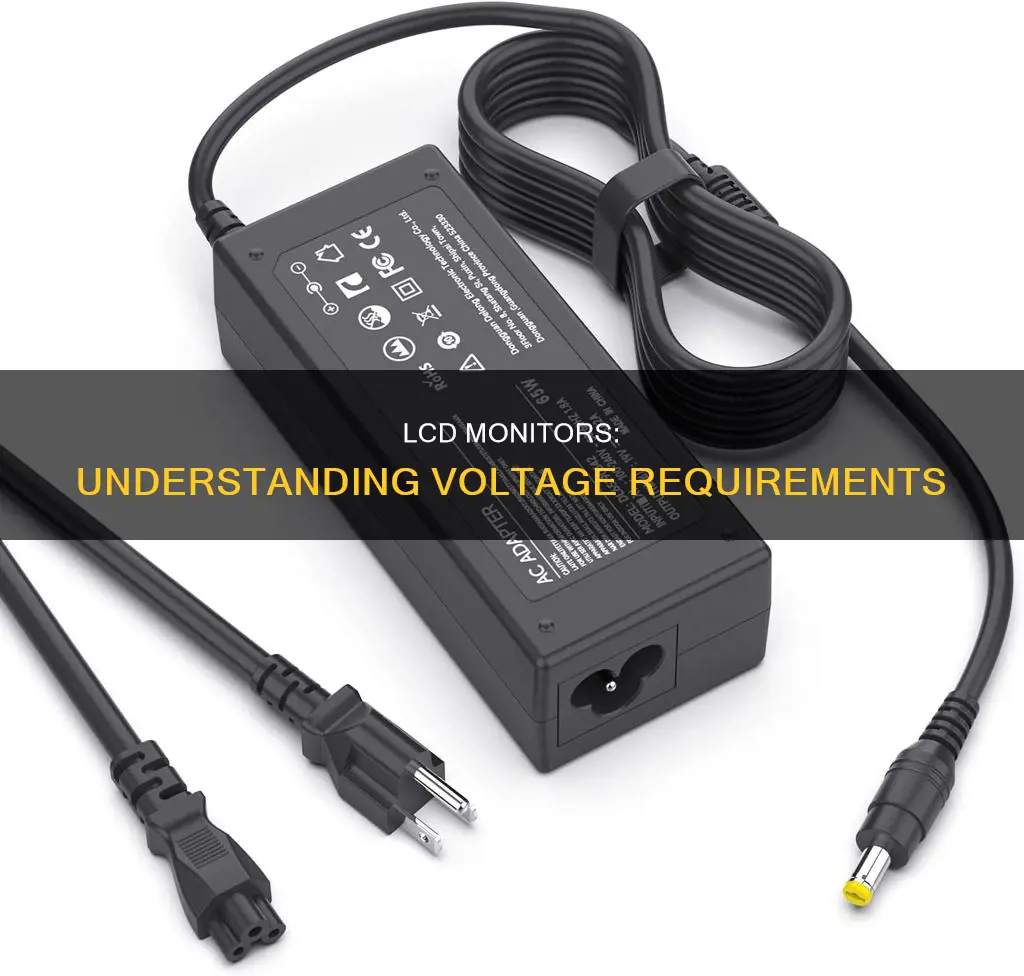
LCD monitors have varying power requirements, with some running on 12V, 15V, or 19V. The voltage will depend on the specific model and type of LCD monitor. Some LCD monitors have external power bricks, which makes it easy to determine the output voltage. However, if the power supply is internal, it may be more challenging to identify the voltage requirements. It's important to match the correct voltage to avoid damaging the monitor or the computer. Additionally, the backlight of an LCD display may require a separate power supply, typically in the form of a high-frequency AC voltage.
| Characteristics | Values |
|---|---|
| LCD Voltage Terminology | VCC, VDD, VSS, VEE |
| VCC and VDD | Used for positive voltage |
| VSS and VEE | Used for ground |
| V0 | Used to vary screen brightness or contrast |
| LCD Driving Voltage | Depends on temperature; the colder the temperature, the higher the LCD voltage |
| Backlight Voltage | Requires a few thousand volts peak at a few tens of kHz AC to ignite; once running, the voltage drops to a few hundred volts |
What You'll Learn

LCD monitors can run on 12-volt batteries
Most LCD monitors have internal power supplies that regulate and distribute the required voltages to the different components. These components often include the backlight, which typically requires a higher voltage than the other parts of the monitor. For example, a 220-240V mains voltage may be rectified to produce a stable DC bus of around 160V or 340V, which is then used to generate the various DC rails for the different components.
To run an LCD monitor on a 12-volt battery, you would need to find a way to bypass the internal power supply and connect the battery directly to the components that require 12 volts. This can be challenging, as it requires taking apart the monitor and identifying the appropriate points to connect the battery. It's important to note that not all LCD monitors will have components that run on 12 volts, so this approach may not work for every monitor.
Additionally, you would need to consider the current requirements of the monitor. While a 12-volt battery can provide the required voltage, it may not have enough current (amperage) to power the monitor for an extended period. In such cases, connecting multiple batteries in series or using a more powerful battery may be necessary.
It's worth mentioning that there are LCD monitors specifically designed for automotive or marine use, which are intended to run on 12-volt power sources. These monitors typically have external power bricks that accept 12-volt DC input, making them a more straightforward option for running on batteries. When choosing an LCD monitor for this purpose, it's important to consider the power requirements and ensure that it can be safely and effectively powered by a 12-volt battery.
Monitoring Children's Tech Usage: Parenting in the Digital Age
You may want to see also

LCD monitors can have external or internal power supplies
The power supply voltage for LCD monitors can vary depending on the specific model and its features. Some LCD monitors have internal power supplies, while others have external power bricks or adapters.
For LCD monitors with external power supplies, the output voltage is usually specified on the power brick or adapter. It is important to use the correct voltage to avoid damaging the monitor. For example, a monitor that requires a 19V power source should not be connected to a 15V adapter, as this could lead to potential damage.
On the other hand, LCD monitors with internal power supplies may have multiple voltage outputs operating simultaneously. In this case, connecting a different power source directly to the board may not work, and taking apart the LCD monitor to access the internal power supply can be challenging.
Additionally, LCD monitors may have different voltage requirements for their backlights. Some LCD displays use fluorescent tubes for backlighting, which typically require high voltages to operate. These tubes may also require specific frequencies and currents for proper functioning.
In summary, LCD monitors can have either external or internal power supplies. It is important to refer to the specific model's documentation or power supply specifications to ensure the correct voltage is used. Attempting to power an LCD monitor with an incorrect voltage can lead to damage or improper functioning of the display.
Monitoring Hotspot Usage: A Guide for Samsung Note 8 Users
You may want to see also

LCD monitors can have several different voltage outputs
The voltage requirements for an LCD monitor can vary depending on its specific components and features. Some LCD monitors may have multiple voltage outputs, with different voltages being used for different components. For example, the backlight of an LCD monitor typically requires a higher voltage than the logic and LCD proper.
The voltage requirements for an LCD monitor can also depend on the specific model and manufacturer. Different models may have different power requirements, and it is important to use the correct power supply to avoid damaging the monitor. It is recommended to consult the manufacturer's specifications or seek expert advice when determining the appropriate voltage for an LCD monitor.
In some cases, an LCD monitor may be able to operate with a range of voltages. For instance, a segment, character, or graphic display may operate with a VDD of 5V or 3.3V, and it may be possible to drive the display with a lower voltage, although the performance may be impacted, especially in colder temperatures.
Additionally, the voltage requirements for an LCD monitor can be influenced by the ambient temperature. In general, colder temperatures require higher voltages to maintain optimal display performance. It is important to consider the operating environment when determining the appropriate voltage for an LCD monitor.
Monitoring Data Usage: Control Your Router's Data Consumption
You may want to see also

LCD monitors can be powered by DC current
The voltages VCC, VDD, VSS and VEE are used in describing voltages at various common power supply terminals. In general, VCC and VDD are used for positive voltage, and VSS and VEE are for ground. The LCD voltage terminology originated from the terminals of each type of transistor and their common connections in logic circuits.
The LCD driving voltage is usually between 3V and 5V. The minimum and maximum voltages are specified in the data sheet of the LCD module. The LCD voltage can be adjusted to provide the sharpest contrast. The colder the temperature, the higher the LCD voltage needs to be.
The backlight of an LCD monitor is powered by DC current. The LED backlight can be supplied from any one of three locations: pins 15 and 16, the 'A' and 'K' connections on the right side of the PCB, or pins one and two.
Monitoring Toilet Usage: Smart Solutions for Efficient Management
You may want to see also

LCD monitors can be powered by AC current
LCD monitors require specific voltages to function, and it is important to ensure that the correct power source is used. For example, a PC monitor may require a 19V 2.6A power source, but using a 15V 5A power source can still work without damaging the monitor. However, it is recommended to use the specified power source to avoid potential issues.
The voltage requirements for LCD monitors can vary, and it is important to refer to the specific model's requirements. Some LCD monitors may have an external power brick that specifies the output voltage. If the power supply is internal, accessing this information may require disassembling the monitor.
It is worth noting that the voltage requirements for the backlight may differ from the voltage requirements for the LCD display itself. The backlight may require a higher voltage, which is then stepped down to power the LCD display.
In summary, LCD monitors can be powered by AC current, and the specific voltage requirements can vary depending on the model and components, such as the backlight. It is important to refer to the specified power requirements to ensure the safe and optimal functioning of the LCD monitor.
LCD Monitors: Handling Both NTSC and PAL Signals
You may want to see also
Frequently asked questions
LCD monitors can run at a range of voltages. The power supply is usually either internal or external. If it is external, the output voltage is usually specified. If it is internal, you will have to take the back of the LCD apart to find out. LCD monitors can run at 12V, 5V, 3.3V, 1.8V, 200V, and more.
Yes, but it is not recommended. You will have to take the back of the LCD apart to connect a DC power source.
V0 is used to vary the screen brightness or contrast.







